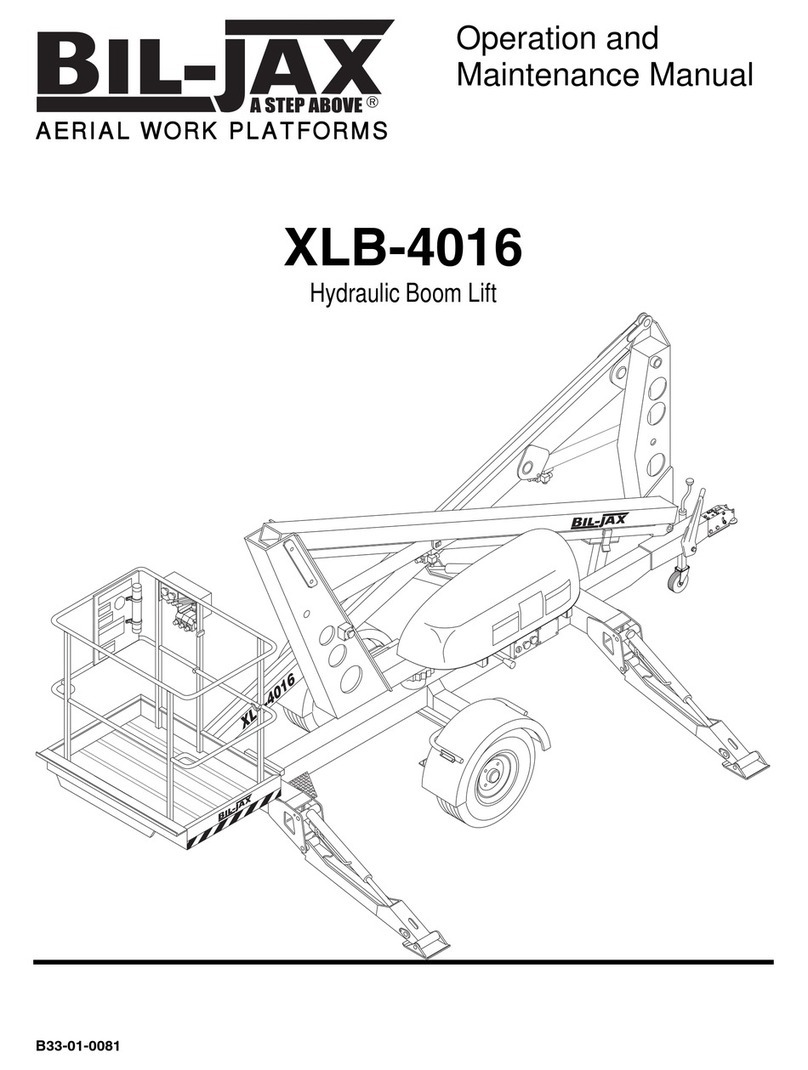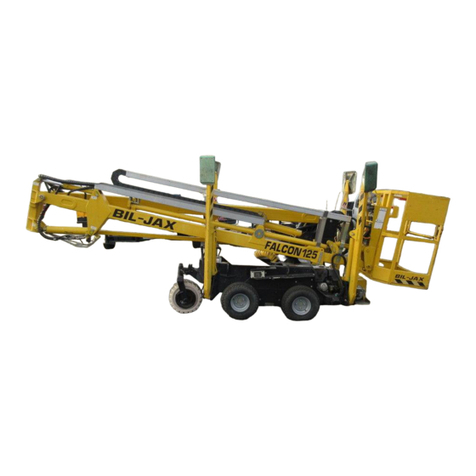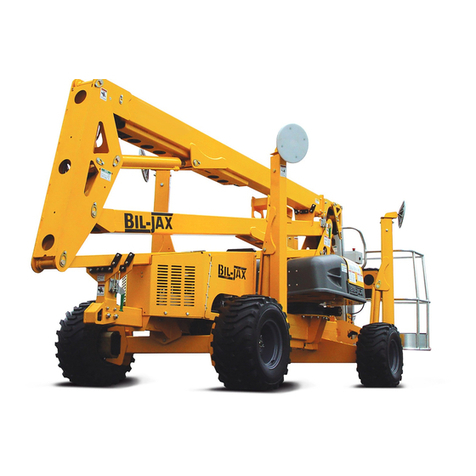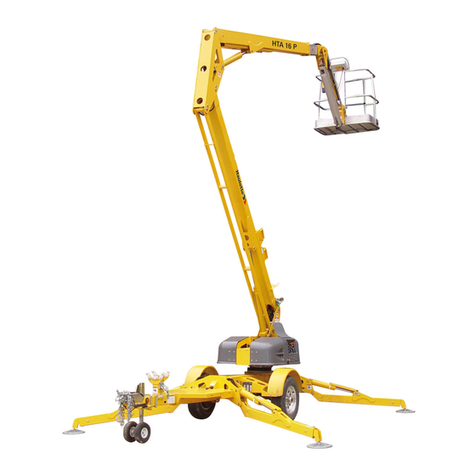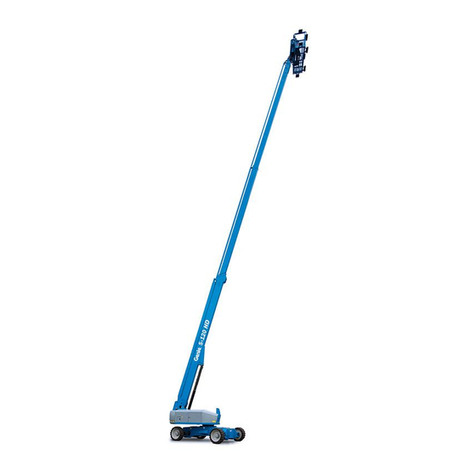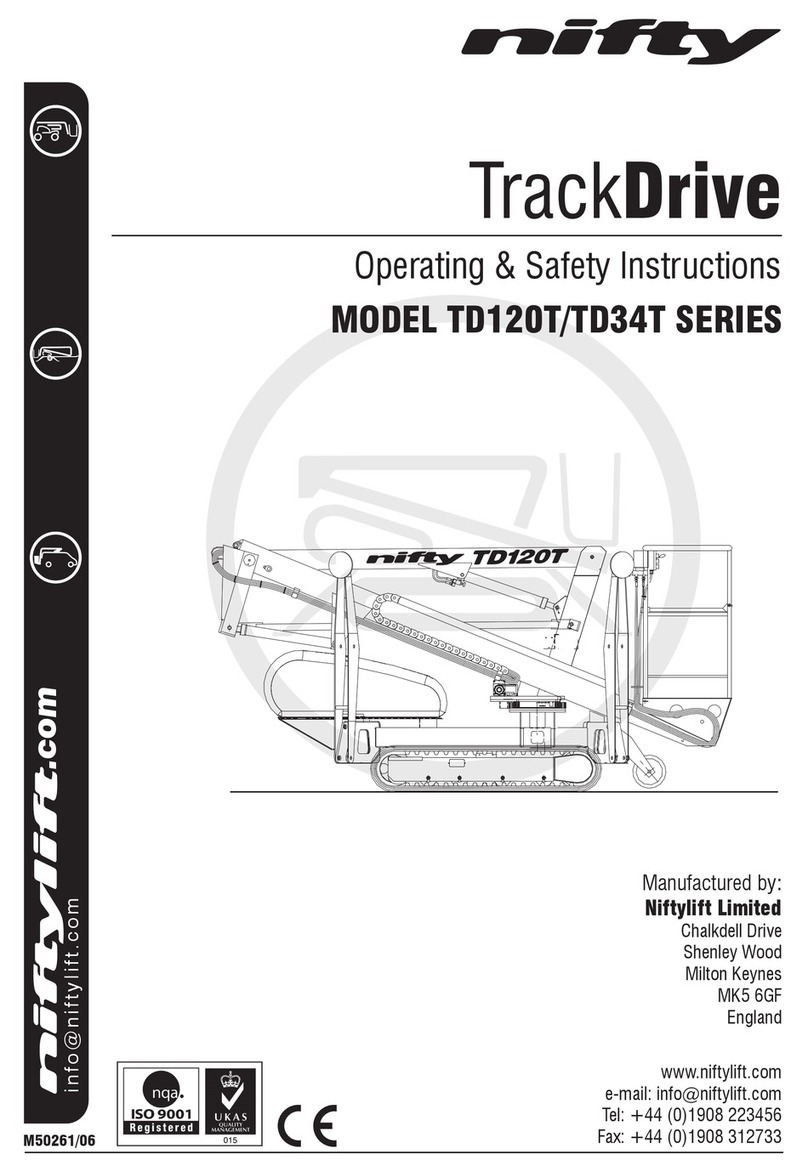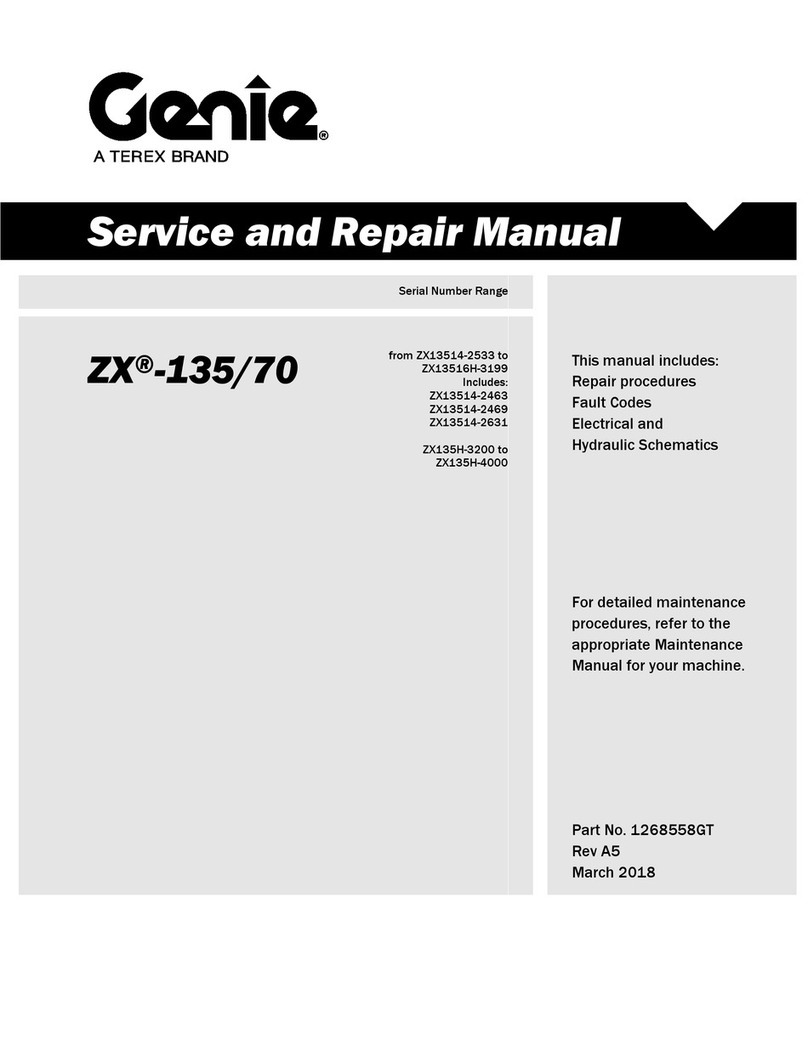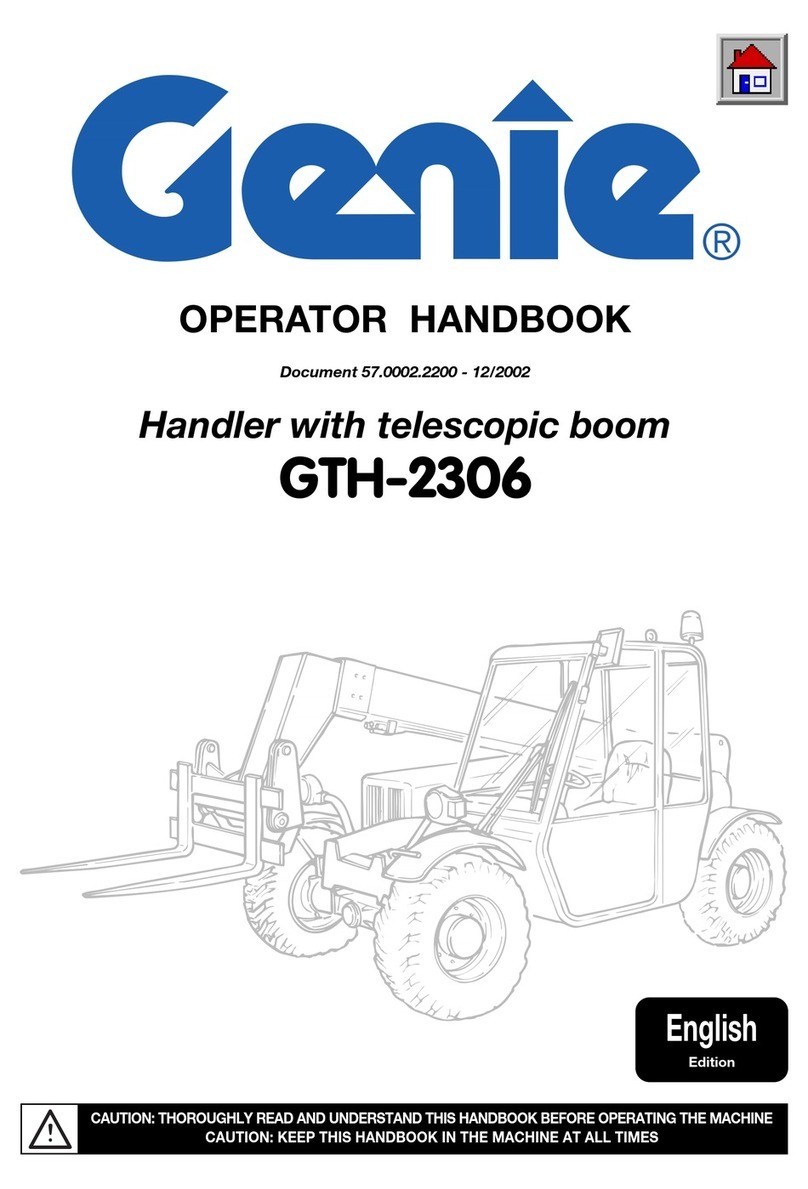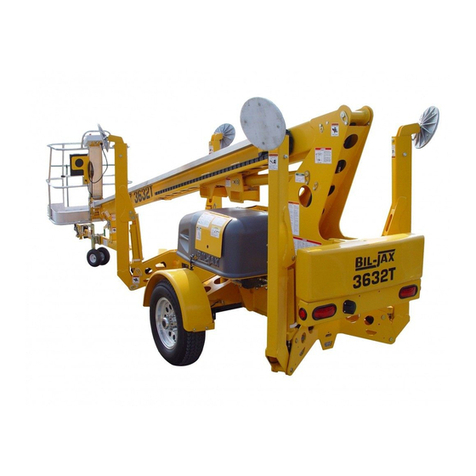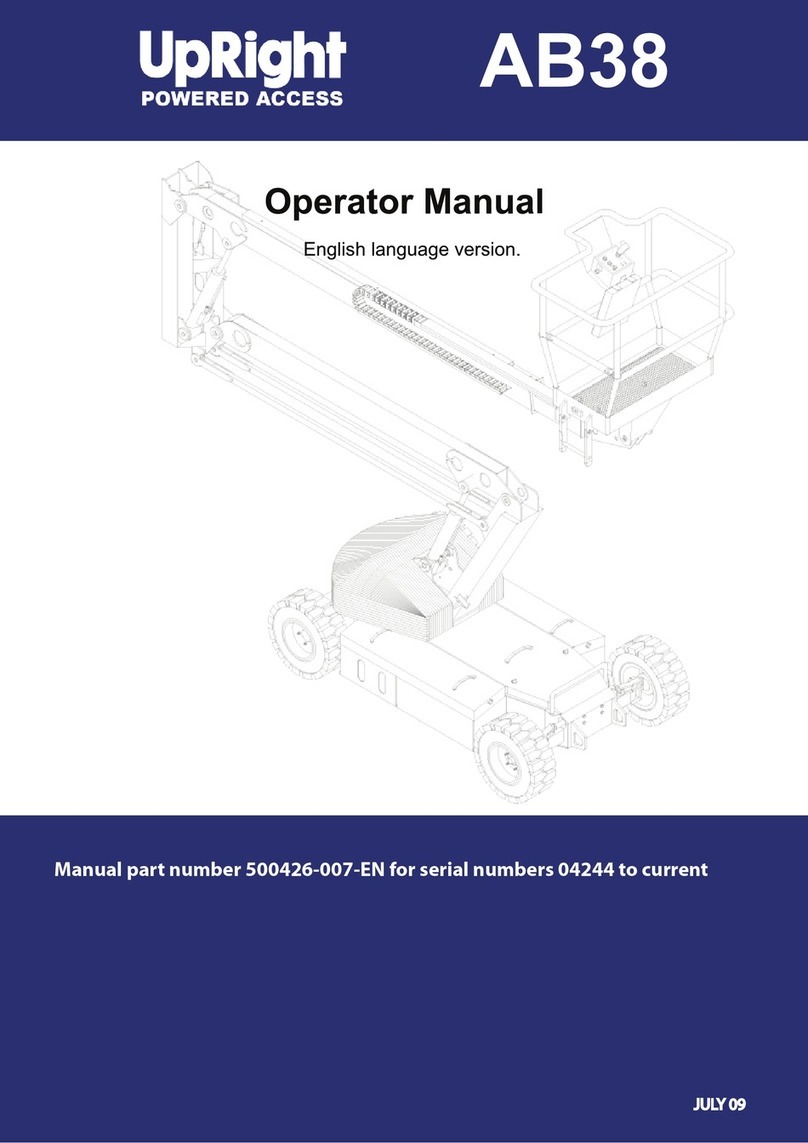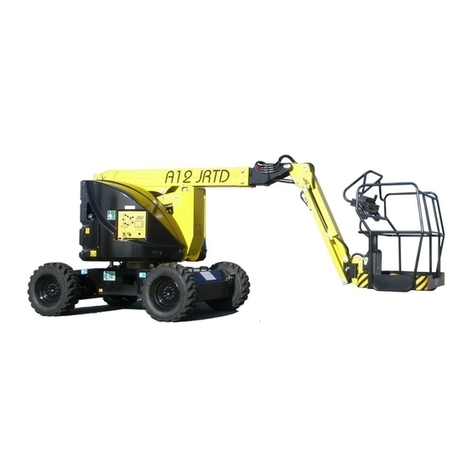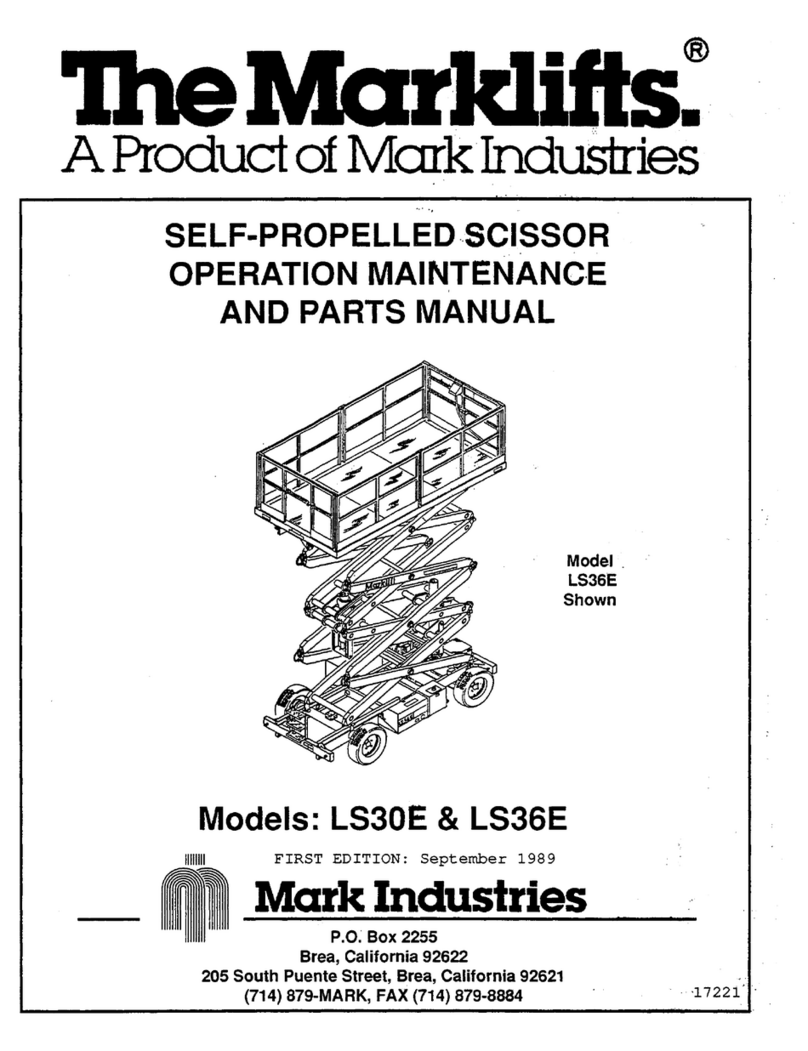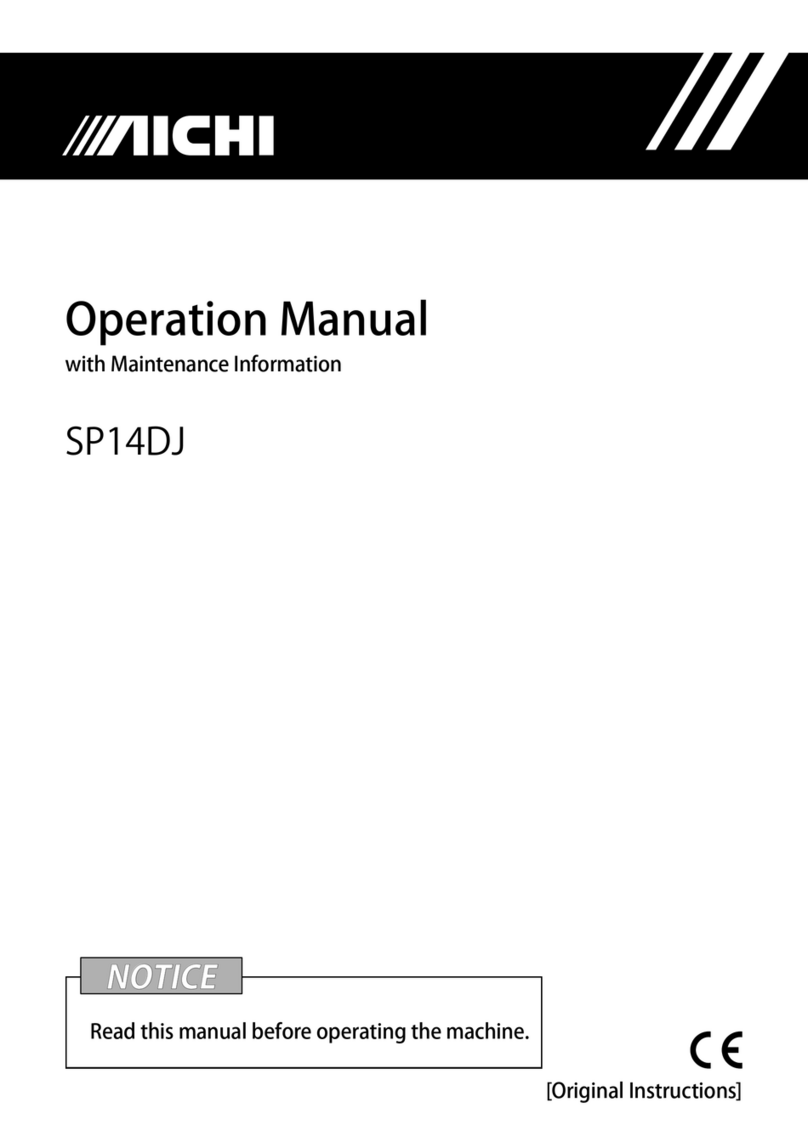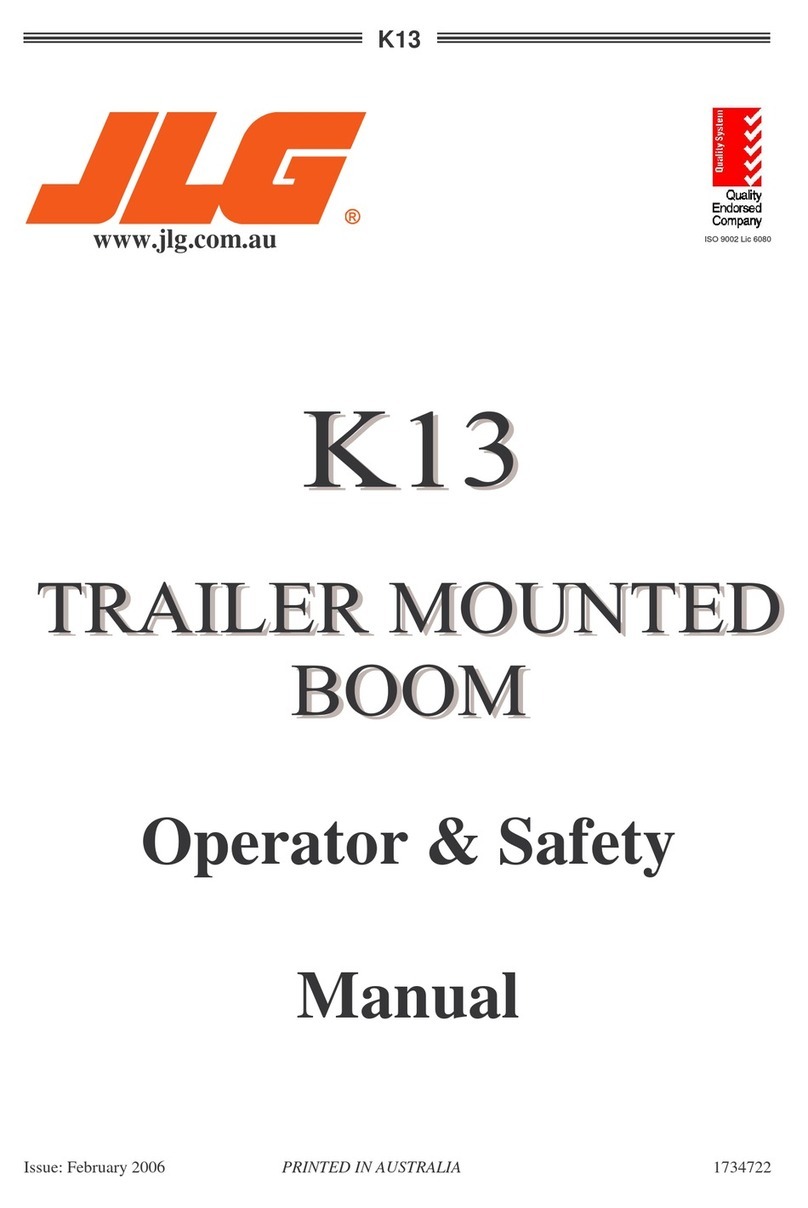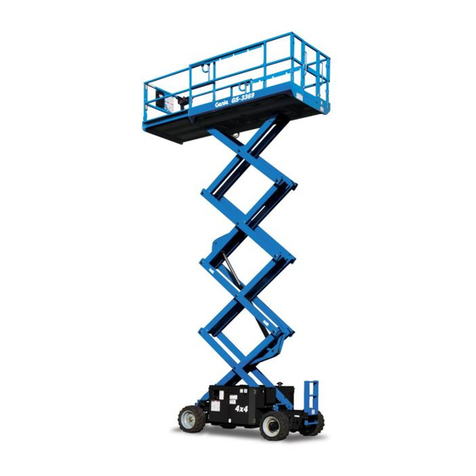BilJax 5031A Quick start guide

Parts and
Service Manual
AERIAL WORK PLATFORMS
5031A
Hydraulic Boom Lift
BIL- AX
B33-01-0092

BOOM PERSONNEL LIFT
This equipment is designed and manufactured in compliance with the duties,
responsibilities, and standards set forth for manufacturers in the ANSI 92.2
standard in effect at the time of manufacture.
This equipment will meet or exceed applicable OSHA codes and ANSI A92.2
standards when used in accordance with sections 7, 8, 9 & 10 of ANSI A92.2 and all
other manufacturer’s recommendations.
It is the responsibility of the user of this equipment to follow all applicable ANSI,
OSHA, Federal, State, and local codes and regulations that govern the safe
operation of this equipment.

i
Table of Contents
PREFACE.................................................................................................iv
1Safety................................................................................................................1-1
1-1 Introduction.............................................................................................1-1
1-2 Before Operation.....................................................................................1-3
1-3 During Operation....................................................................................1-4
1-4 Maintenance Safety.................................................................................1-5
1-5 Damaged Equipment Policy....................................................................1-7
2Introduction.....................................................................................................2-1
2-1 General Description ................................................................................2-1
2-2 Specifications..........................................................................................2-4
2-3 Warranty .................................................................................................2-5
3Operation.........................................................................................................3-1
3-1 Operator Controls....................................................................................3-1
3-2 Normal Operating Procedure..................................................................3-7
3-3 Emergency Lowering..............................................................................3-9
3-4 Manual Boom Operations.....................................................................3-10
3-5 Manual Boom Rotation.........................................................................3-11
3-6 Battery Recharge (DC Model Only) .....................................................3-12
3-7 Boom Lift Transport .............................................................................3-14
4Operator Service.............................................................................................4-1
4-1 Scheduled Service Checks......................................................................4-1
4-2 Wheel Nut Torque Requirements............................................................4-3
4-3 Lubrication..............................................................................................4-4
4-4 Hydraulic System....................................................................................4-5
4-5 Slew Ring Bearing................................................................................4-16
4-6 Limit Switch checks and adjustments...................................................4-17
4-7 Troubleshooting....................................................................................4-19
4-8 Material Safety Data Sheets..................................................................4-26
5Replacement Decals ........................................................................................5-1
6Parts List..........................................................................................................6-1
6-1 Towing Assemblies.................................................................................6-2
6-2 Fender, Axle, and Wheel Assemblies.....................................................6-4
6-3 Turntable and Slew Components............................................................6-6
6-4 Outrigger Components............................................................................6-8
6-5 Lower Controls .....................................................................................6-10
6-6 Lower Control Box Components..........................................................6-12
6-7 Pump Compartment ..............................................................................6-14
6-8 Battery Compartment............................................................................6-16
6-9 Compartment Covers ............................................................................6-18
6-10 Lower Boom Components....................................................................6-20
6-11 Upper Boom Components....................................................................6-22
6-12 Telescopic Boom Components.............................................................6-24
6-13 Cable/Hose Track Components............................................................6-26
6-14 Jib Boom Components .........................................................................6-28
6-15 Platform Components...........................................................................6-30
6-16 Upper Controls.....................................................................................6-32
6-17 Hydraulic Pump Unit Components ......................................................6-34
6-18 Upper Control Panel Components........................................................6-36
7ANSI Reprint...................................................................................................7-1

ii
List of Illustrations
Figure 2-1. Bil-Jax 5031A Hydraulic Boom Lift...................................................... 2-1
Figure 2-2. Platform and Ground Station Controls................................................... 2-2
Figure 2-3. Safe Operating Zone............................................................................... 2-3
Figure 3-1. Pump Compartment Access ................................................................... 3-1
Figure 3-2. Ground Station Controls......................................................................... 3-3
Figure 3-3. Pump Compartment................................................................................ 3-4
Figure 3-4. Engine Key Switch................................................................................. 3-4
Figure 3-5. Platform Control Station ........................................................................ 3-5
Figure 3-6. Outrigger Controls.................................................................................. 3-7
Figure 3-7. Emergency Descent (Lowering) Switches ............................................. 3-9
Figure 3-8. Emergency Lowering Valve................................................................. 3-10
Figure 3-9. Manual Pump Operation ...................................................................... 3-10
Figure 3-10. Slew Motor Bypass Valve.................................................................... 3-11
Figure 3-11. Battery Charger .................................................................................... 3-12
Figure 3-12. Trailer Hitching.................................................................................... 3-14
Figure 4-1. Wheel Nut Tightening Sequence............................................................ 4-3
Figure 4-2. Lubricate Monthly.................................................................................. 4-4
Figure 4-3. Lubricate Semi-Annually ....................................................................... 4-4
Figure 4-4. Hydraulic Reservoir ............................................................................... 4-5
Figure 4-5. Main Relief Valve and Pressure Test Port (Gas Engine Model)........... 4-7
Figure 4-6. Outriggers Relief Valve.......................................................................... 4-8
Figure 4-7. Boom Control Relief Valve, Platform Station........................................ 4-9
Figure 4-8. Hydraulic Cylinder Removal................................................................ 4-11
Figure 4-9. Jib Boom Components ......................................................................... 4-14
Figure 4-10. Platform Rotation Cylinder .................................................................. 4-15
Figure 4-11. Slew Ring Position Measurement ........................................................ 4-16
Figure 4-12. Boom Down Limit Switch.................................................................... 4-17
Figure 4-13. Outrigger Position Switch.................................................................... 4-18
Figure 4-14. Simplified Electrical Diagram, DC Model........................................... 4-21
Figure 4-15. Detailed Electrical Diagram, DC Model .............................................. 4-22
Figure 4-16. Hydraulic Diagram, Sheet 1 of 2.......................................................... 4-23
Figure 4-17. Level Sensor......................................................................................... 4-25
Figure 5-1. Replacement Decals, Sheet 1 of 4.......................................................... 5-2
Figure 5-2. Decal Locations, Trailer and Boom........................................................ 5-6
Figure 5-3. Decal Locations, Platform...................................................................... 5-7
Figure 5-4. Lubricate Monthly Decal........................................................................ 5-7
Figure 5-5. Lubricate Semi-Annually Decal............................................................. 5-7
Figure 6-1. Towing Assemblies................................................................................ 6-2
Figure 6-2. Fender, Axle, and Wheel Assemblies .................................................... 6-4
Figure 6-3. Turntable and Slew Components ........................................................... 6-6
Figure 6-4. Outrigger Components........................................................................... 6-8
Figure 6-5. Lower Controls..................................................................................... 6-10
Figure 6-6. Lower Control Box Components, Sheet 1 of 2 .................................... 6-12
Figure 6-7. Pump Compartment.............................................................................. 6-14
Figure 6-8. Battery Compartment ........................................................................... 6-16
Figure 6-9. Compartment Covers............................................................................ 6-18
Figure 6-10. Lower Boom Components.................................................................... 6-20
Figure 6-11. Upper Boom Components.................................................................... 6-22
Figure 6-12. Telescopic Boom Components............................................................. 6-24
Figure 6-13. Cable/Hose Track Components............................................................ 6-26
Figure 6-14. Jib Boom Components ......................................................................... 6-28
Figure 6-15. Platform Components........................................................................... 6-30
Figure 6-16. Upper Controls..................................................................................... 6-32
Figure 6-17. Hydraulic Pump Unit Components ...................................................... 6-34
Figure 6-18. Upper Control Panel Components........................................................ 6-36

iii
List of Tables
Table 1-1. Minimum Safe Approach Distances.........................................................1-4
Table 2-1. Specifications...........................................................................................2-4
Table 3-1. Charger Fault Codes...............................................................................3-13
Table 4-1. Daily/Weekly Service Checks..................................................................4-1
Table 4-2. Monthly Service Checks ..........................................................................4-2
Table 4-3. Troubleshooting Chart ...........................................................................4-19
Table 4-4. Level Sensor LEDs ................................................................................4-25
Table 5-1. Replacement Decals.................................................................................5-1
Table 6-1. Towing Assemblies Parts List..................................................................6-3
Table 6-2. Fender, Axle, and Wheel Assemblies Parts List ......................................6-5
Table 6-3. Turntable and Slew Components Parts List.............................................6-7
Table 6-4. Outrigger Components Parts List.............................................................6-9
Table 6-5. Lower Controls Parts List ......................................................................6-11
Table 6-6. Lower Control Box Parts List ................................................................6-13
Table 6-7. Pump Compartment Parts List ...............................................................6-15
Table 6-8. Battery Compartment Parts List.............................................................6-17
Table 6-9. Compartment Covers Parts List .............................................................6-19
Table 6-10. Lower Boom Parts List ..........................................................................6-21
Table 6-11. Upper Boom Parts List...........................................................................6-23
Table 6-12. Telescopic Boom Parts List....................................................................6-25
Table 6-13. Cable/Hose Track Parts List...................................................................6-27
Table 6-14. Jib Boom Parts List................................................................................6-29
Table 6-15. Platform Parts List..................................................................................6-31
Table 6-16. Upper Controls Parts List.......................................................................6-33
Table 6-17. Hydraulic Pump Unit Parts List .............................................................6-35
Table 6-18. Upper Control Panel Parts List ..............................................................6-36
Table 6-19. Hydraulic Hose Listing ..........................................................................6-37
Table 7-1. Minimum Safe Approach Distance (M.S.A.D.) to energized
(exposed or insulated) power lines and parts. ........................................7-11

iv
PREFACE
The purpose of this manual is to provide a thorough understanding of the
Bil-Jax 5031A Hydraulic Boom Lift operation and maintenance procedures.
Read the safety, operating and maintenance instructions in this manual and
become familiar with the location and use of all controls.
Follow all warnings, cautions, and instructions in this manual and any
attached to and supplied with the boom lift. All OSHA, ANSI, state, and
local codes and regulations concerning this equipment should be obtained,
read, and thoroughly understood before attempting to operate or service this
equipment.
To ensure proper and safe use of this equipment, only trained and qualified
personnel should operate and maintain the boom lift.

1-1
1
Safety
1-1
ned
ety
al.
implemented at all
considered as legal advice and is intended
to
For any questions concerning the safe use of this equipment, call 800-537-0540 before
operating.
INTRODUCTION
Familiarity and proper training are required for the safe operation and maintenance of
mechanical equipment. Equipment operated or serviced improperly or by untrai
personnel can be dangerous. Read the operating and maintenance instructions in this
manual and become familiar with the location and proper use of all controls.
Inexperienced operators should receive instruction from someone familiar with the
equipment before being allowed to operate the machine. The use of intelligence and
common sense in the operation of mechanical equipment is the best practice in any saf
policy. Be professional and always observe the safety procedures set forth in this manu
All OSHA, ANSI, state, and local codes and regulations pertaining to this equipment
should be obtained, read, and thoroughly understood before attempting to operate this
equipment. Persons under the influence of drugs, alcohol, or prescription medication
should not be on or near this equipment. Common sense should be
times during the use of this equipment. Do not operate this equipment in areas where the
equipment or user may come in contact with a live power source.
The information contained herein is not to be
for informational purposes only. This information is offered to alert Bil-Jax customers
procedures that may be of concern to them.
This information is not intended to be all inclusive and is to be followed in the use of
Bil-Jax equipment only.

BIL-JAX 5031A
1-2
SAFETY NOTES
This manual contains DANGERS, WARNINGS, CAUTIONS, and NOTES that
must be followed to prevent the possibility of improper service, personnel injury
or death, and damage to equipment.
DANGER
Dangers warn of equipment operation near electrical power lines that could
lead to personal injury or death.
WARNING
Warnings describe conditions or practices that could lead to personal injury
or death.
CAUTION
Cautions provide information important to prevent errors that could damage
machine or components.
NOTE: Notes contain additional information important to a procedure.

1 — SAFETY
1-3
1-2 BEFORE OPERATION
Ensure the following general safety precautions are followed before operating the
Bil-Jax 5031A Hydraulic Boom Lift.
• ALWAYS survey the usage area for potential hazards such as untamped earth
fills, unlevel surfaces, overhead obstructions, and electrically charged
conductors or wires. Be aware of any potential hazards and always consider
what could happen. Watch for moving vehicles in the operating area.
• ALWAYS read, understand, and follow the procedures in this manual before
attempting to operate equipment.
• ALWAYS inspect the equipment for damaged or worn parts. Check for cracked
welds, hydraulic leaks, damaged wiring, loose wire connectors, damaged
outriggers, low tire pressure, uneven tire wear, or tire damage. Also check for
any improper operation. NEVER operate equipment if damaged in any way.
Improperly operating equipment must be repaired before using.
• ALWAYS wear proper clothing for the job. Wear protective equipment as
required by federal, state, or local regulations. The operator MUST wear a
safety harness and lanyard.
• ALWAYS locate, read, and follow all directions and warnings displayed on the
equipment.
• ALWAYS inspect the equipment for “DO NOT USE” tags. NEVER use
equipment tagged in this way until all repairs are made and all “DO NOT USE”
tags are removed by authorized maintenance personnel.
• ALWAYS make sure the platform and outrigger pads are free of mud, grease, or
other slippery material to reduce the possibility of slipping.
• NEVER allow improperly trained personnel to operate this equipment. Only
trained and authorized personnel shall be allowed to operate this equipment.
• NEVER operate this equipment if you are under the influence of alcohol or
drugs, or if you feel ill, dizzy, or unsteady in any way. Operators must be
physically fit, thoroughly trained, and not easily excitable.
• NEVER modify, alter, or change the equipment in any way that would affect its
original design or operation in any way.
• NEVER operate this equipment in ways for which it is not intended.

BIL-JAX 5031A
1-4
1-3 DURING OPERATION
Ensure the following general safety precautions are followed during the operation of the
Bil-Jax 5031A Hydraulic Boom Lift.
DANGER
This machine is not insulated for use near electrical power lines and DOES NOT
provide protection from contact with or close proximity to any electrically
charged conductor. Operator must maintain safe clearances at all times (10 feet
minimum) and always allow for platform movement such as wind induced sway.
Always contact the power company before performing work near power lines.
Assume every line is hot. Remember, power lines can be blown by the wind.
Refer to Table 1-1 for minimum safe approach distances between machine and electrical
power lines.
Table 1-1. Minimum Safe Approach Distances
Minimum Safe Approach Distance
Voltage Range
(Phase to Phase) (Feet) (Meters)
0 to 300V Avoid Contact
Over 300V to 50KV 10 3.05
Over 50KV to 200KV 15 4.60
Over 200KV to 350KV 20 6.10
Over 350KV to 500KV 25 7.62
Over 500KV to 750KV 35 10.67
Over 750KV to 1000KV 45 13.72
• ALWAYS position lift far enough away from power sources to ensure that no
part of the lift can accidentally reach into an unsafe area. This includes full
extension of the boom through 360 degrees rotation.
• ALWAYS operate only on a firm and level surface. NEVER use on surfaces
that do not support the equipment with its rated load capacity and the resulting
force exerted on the outriggers during boom extension and rotation.
• ALWAYS keep yourself and all personnel away from potential pinch or shear
points.
• ALWAYS report any misuse of equipment to the proper authorities. Horseplay
is prohibited.
• ALWAYS maintain good footing on the work platform. NEVER wear slippery
soled shoes.
• ALWAYS make certain all personnel are clear and there are no obstructions
before repositioning platform.
• ALWAYS cordon off area around the outriggers to keep personnel and other
equipment away from it while in use.
• ALWAYS stay clear of wires, cables, and other overhead obstructions.
• ALWAYS engage the boom travel locking pins before towing the trailer.

1 — SAFETY
1-5
• NEVER allow electrode contact with any part of the platform if welding is
being performed from the platform.
• NEVER use without the outriggers fully extended and firmly based.
• NEVER override or by-pass manufacturer's safety devices.
• NEVER attach a safety harness to an adjacent structure, pole, or equipment
while working from the boom platform.
• NEVER move unit with a person or materials on board.
• NEVER try to move the trailer with the boom extended.
• NEVER stand or sit on cage bars. Work only within the work cage and do not
lean out over the cage to perform work.
• NEVER attempt to increase working height with boxes, ladders, or other means.
• NEVER operate this equipment when exposed to high winds, thunderstorms,
ice, or any other weather conditions that would compromise operator safety.
• NEVER allow ropes, electric cords, hoses, etc. to become entangled in the
equipment when the platform is being raised or lowered.
• NEVER exceed manufacturer's load limits or use the lift as a crane for lifting
heavy materials. Make sure all tools and equipment are safely stowed.
• NEVER exceed load ratings by transferring loads to the platform at elevated
heights.
• NEVER use cage to carry materials and never allow overhang of materials when
raising or lowering the platform.
• NEVER push or pull with the boom or platform and NEVER use the boom to
lift any part of the trailer.
• NEVER use the boom or platform to place a “dead man” load against any
structure, materials, or equipment.
• NEVER climb up or down boom.
• NEVER leave the keys in the boom lift while unattended or not in use.
1-4 MAINTENANCE SAFETY
Ensure the following safety precautions are observed whenever maintenance is
performed on the 5031A Hydraulic Boom Lift.
General Maintenance
• ALWAYS perform maintenance procedures according to manufacturer's
requirements. NEVER short change maintenance procedures.
• ALWAYS check hydraulic system. Make sure all lines, connectors, and fittings
are tight and in good condition.
• ALWAYS turn the key switch off before connecting or disconnecting wiring to
or from valve solenoids or other load devices.
• ALWAYS disconnect power to the hydraulic pump drive motor before making
electrical checks of the hydraulic valves.
• ALWAYS keep all mechanisms properly adjusted and lubricated according to
maintenance schedule and manufacturer’s specifications.

BIL-JAX 5031A
1-6
• ALWAYS perform a function check of operating controls before each use and
after repairs have been made.
• ALWAYS locate and protect against possible pinch points prior to performing
maintenance and repairs.
• ALWAYS use factory-approved parts to repair or maintain this equipment. If
this equipment is rebuilt, retesting is required in accordance with factory
instructions.
• NEVER allow water or foreign particles into the DC electric motor housing.
Ingestion of water or foreign particles may cause serious damage to the motor.
If the motor gets wet, oven dry the motor to remove all moisture before
operating; consult motor manufacturer for drying instructions.
• NEVER test or operate the hydraulic components when another person is near
the equipment.
• NEVER add unauthorized fluids to the hydraulic system or battery. Check
original manufacturer specifications.
• NEVER exceed the manufacturer's recommended relief valve settings.
• NEVER touch or allow metal tools to contact static discharge sensitive
electronic components. ALWAYS use static discharge prevention mats and
grounding devices when handling electronic components.
• NEVER tamper with cylinder counter balance valves. Contact the Bil-Jax
Service Department at 800-537-0540 if the cylinder counter balance valves need
adjusting.
• NEVER attempt repairs you do not understand. Consult manufacturer if you
have any questions regarding proper maintenance, specifications, or repair.
Battery Maintenance
Ensure the following general safety precautions are followed whenever performing
battery maintenance on the Bil-Jax 5031A Hydraulic Boom Lift.
• ALWAYS check battery acid level daily. Check battery test indicator for proper
state of charge on maintenance free batteries before using lift.
• ALWAYS wear safety glasses when working near battery.
• ALWAYS avoid contact with battery acid. Battery acid causes serious burns.
Avoid contact with skin or eyes. If accidental contact occurs, flush with water
and consult a physician immediately.
• ALWAYS disconnect ground cable first when removing battery.
• ALWAYS connect ground cable last when installing battery.
• ALWAYS charge batteries in open, well-ventilated areas.
• NEVER smoke when servicing battery.
• NEVER allow batteries to overcharge and boil.
• NEVER short across battery posts to check for current. NEVER break a live
circuit at battery.
• NEVER jump start other vehicles using boom lift battery.

1 — SAFETY
1-7
1-5 DAMAGED EQUIPMENT POLICY
Safety Statement
At Bil-Jax, we are dedicated to the safety of all users of our products. Therefore, all
Bil-Jax lifts are designed, manufactured and tested to comply with current applicable
Federal OSHA and ANSI codes and regulations.
Damage Policy
There may be occasions when a Bil-Jax lift is involved in an incident that results in
structural damage to the lift. This can seriously compromise the ability of the lift to
perform in a safe manner. Therefore, whenever a Bil-Jax lift is damaged structurally or
when there is the possibility of structural damage (this damage may be internal and is not
always visible to the naked eye), Bil-Jax may require that the lift be returned to our
facility at 125 Taylor Parkway, Archbold, Ohio, for reconditioning. If you have any
questions concerning what constitutes structural damage, please call the Bil-Jax Service
Department at 800-537-0540.
Damage Repair Notice
There may be occasions when a Bil-Jax lift is involved in an incident resulting in non-
structural damage. When this occurs and repairs are made by the owner or area
distributor, please notify Bil-Jax of these non-maintenance repairs and request a repair
form to be filled out and returned to Bil-Jax.

BIL-JAX 5031A
1-8
Bil-Jax, Inc.
125 Taylor Parkway
Archbold, Ohio 43502
Reporting Safety Defects
If you believe that your vehicle has a defect which could cause a crash or could cause
injury or death, you should immediately inform the National Highway Traffic Safety
Administration (NHTSA) in addition to notifying Bil-Jax, Inc.
If NHTSA receives similar complaints, it may open an investigation, and if it finds that a
safety defect exists in a group of vehicles, it may order a recall and remedy campaign.
However, NHTSA cannot become involved in any individual problems between you,
your dealer, or Bil-Jax, Inc.
To contact NHTSA you may either call the Auto Safety Hotline toll-free at 1-800-424-
9393 (366-0123 in Washington, DC area) or write to:
NHTSA
U.S. DEPARTMENT of TRANSPORTATION
400 7th Street SW (NSA-11)
Washington, DC 20590
You can also obtain other information about motor vehicle safety from the Hotline.

2-1
2
Introduction
2-1
ols and equipment at overhead work locations. The work platform load
a
form swivel cylinder rotates the platform about 10
degrees clockwise or counterclockwise. A hydraulic motor and worm gear rotates the
GENERAL DESCRIPTION
The Bil-Jax 5031A Hydraulic Boom Lift (Figure 2-1) is designed to position personnel
with their to
capacity is 475 lbs. During all boom operations, the unit is supported by four extended
outriggers.
The hydraulic power unit includes a reservoir, pump, and control valves. Three hydraulic
cylinders elevate the lower boom, upper boom, and jib boom. A fourth cylinder extends
telescopic boom. A master and slave cylinder maintain the work platform at level while
raising or lowering the boom. A plat
boom 360°around a vertical axis.
B
IL- AX
WORK
PLATFORM
JIB
BOOM
TELESCOPIC
BOOM
UPPER
BOOM
LOWER
BOOM
OUTRIGGER
Figure 2-1. Bil-Jax 5031A Hydraulic Boom Lift

BIL-JAX 5031A
2-2
The battery powered boom lift uses a 24 Volt, one horsepower, DC motor to drive the
hydraulic pump. The DC motor is powered by four 6 Volt DC, 275 Amp-hour, deep
charge batteries connected in series. A 40 Amp, automatic, on-board battery charger is
provided for recharging the batteries at the end of each work period.
The boom lift is equipped with platform and ground station controls (Figure 2-2). The
controls include motion enable pushbuttons and proportional hydraulic valves for
controlling the direction and speed of boom lift, extension, and rotation. Boom elevation,
extension, and rotation controls operate only when the outriggers are correctly extended
and the moving boom sections are within a programmed safe operating zone.
Figure 2-2. Platform and Ground Station Controls

2 — INTRODUCTION
2-3
Figure 2-3. Safe Operating Zone
Two boom motion functions are permitted at a time, and only when the boom is within
the safe operating zone (Figure 2-3). When a selected boom motion reaches a safe
operating limit, the boom motion ceases and another boom motion must be selected
within the safe operating zone.
Outrigger load sensing interlocks and interlock safety switches prevent all boom lifting
operations until the four outriggers are properly extended, the trailer is level, and the full
weight of the boom lift is loaded onto the outriggers. An interlock prevents the retracting
of any outrigger while the upper or lower boom is raised two inches (50 mm) or more.
Boom elevation speeds are adjustable from zero to 5.3 inches per second (0 to 27 ft/min).
A hydraulic hose failure at either retract-cylinder port will cause a counterbalance valve
to stop the return oil flow. It is strongly recommended that no one adjust or tamper with
these safety devices. If service is required, please notify Bil-Jax for instructions.
Emergency lowering of the platform is by manual valves on the upper and lower boom
lift cylinders or by manual operation of a hand pump at the lower control station. Firmly
pulling out and holding a valve plunger manually retracts the boom lift cylinder. Smooth
pumping of the hand pump while engaging a single hydraulic valve lever enables boom
operation in case of a hydraulic power failure.
The Bil-Jax 5031A Hydraulic Boom Lift cylinders will not rust or corrode during
storage since the cylinder rod is fully immersed in oil. It is important that the cylinder
rods be kept clean and undamaged for the protection of the cylinder head packings.

BIL-JAX 5031A
2-4
2-2 SPECIFICATIONS
Boom Lift Work Platform
Model Number: 5031A Serial Number ________________
Manufactured by: Bil-Jax, Inc.
BIL-JAX AERIAL WORK PLATFORMS
125 Taylor Parkway
Archbold, Ohio 43502
800-537-0540
Table 2-1. Specifications
Feature Data
Rated Platform Load 475 lbs (215 kg) total
Maximum Work Height 50 ft (13,1 m)
Extended Platform Height 50 ft (15,2 m)
Maximum Outreach 31 ft (9,8 m)
Elevation Rate,
Nominal 5.3 in./sec (135 mm/sec)
[26.7 ft/min (8,14 m/min)]
Horizontal Reach 31 ft (5,9 m)
Boom Rotation 700°
Rotation Speed 318° per Minute, Nominal
Platform Dimensions 48 in. W x 30 in. D x 43 in. H
(122 cm x 76 cm x 109 cm)
Power Source 24 Volt DC, 4 Deep Cycle, 6 Volt,
275 Amp-hour Batteries
Battery Charger, DC Model 120 Volt AC, 40 Amp DC
Hydraulic Pressure 3400 psi (23,442 kPa)
Reservoir Capacity 3.15 Gallons (11,9 Liters)
Hydraulic Capacity 7 Gallons (26,5 Liters)
Hydraulic Oil Energol HLP-HD46 (BP Oil)
Gross Vehicle Weight, DC Model 5291 lbs (2400 kg)
Tongue Weight 300 lbs (136 kg)
Towing Brakes Hydraulic Surge
Parking Brake Mechanical

2 — INTRODUCTION
2-5
2-3 WARRANTY
Bil-Jax warrants its boom lifts for one year from the date of delivery against all defects of
material and workmanship, provided the unit is operated and maintained in compliance
with Bil-Jax’s operating and maintenance instructions; structural components are
warranted for three years. Bil-Jax will, at its option, repair or replace any unit or
component part which fails to function properly in normal use.
This warranty does not apply if the lift and/or its component parts have been altered,
changed, or repaired without the consent of Bil-Jax or by anyone other than Bil-Jax or its
factory trained personnel, nor if the lift and/or its components have been subjected to
misuse, negligence, accident or any conditions deemed other than those considered as
occurring during normal use.
Components not manufactured by Bil-Jax are covered by their respective manufacturer’s
warranties. A list of those components and their warranties is available upon written
request to Bil-Jax.
Bil-Jax shall not in any event be liable for the cost of any special, indirect, or
consequential damages to anyone, product, or thing. This warranty is in lieu of all other
warranties expressed or implied. We neither assume nor authorize any representative, or
other person, to assume for us any other liability in connection with the sale, rental, or
use of this product.

BIL-JAX 5031A
2-6
Table of contents
Other BilJax Boom Lift manuals

